Research Areas

Ignition-assist devices for reliable military UAS application
Performance of unmanned aircraft systems (UAS) is key to the success of the Army's mission, but engines designed for ground vehicles often do not meet the requirements in reliability and power. UAS engines operate at high altitude; failures to ignition can occur because of low intake air temperature. Therefore, ensuring the successful ignition of an UAS engine is critical to the success of the mission. This work is an integrated computational and experimental study in characterizing the interaction of the ignition enhancement device and diesel sprays. The scientific objective is to generate fundamental knowledge associated with the impact of high-speed fuel droplets on a heated surface (~1300 K). This work will contribute significantly to the successful deployment of UAS, which will play a critical role in the future Multi-Domain Operations of the US military, by improving mission success.

Spray-wall interactions at extreme temperatures and pressures
The outcomes of fuel spray impact on heated walls will affect the fuel-air mixture distribution and the subsequent combustion and emissions in internal combustion engines. Existing numerical models for drop-wall interactions are mainly validated for conditions at atmospheric pressure. We have developed a numerical method, based on Smoothed Particle Hydrodynamics (SPH), to simulate the drop impact on a heated wall at high pressures. The effects of high temperature and high pressure on the evaporation of the drop were considered, and numerical predictions were validated by experimental observations. The present method predicted the increase in the critical temperature above which the drop would rebound as the ambient pressure increased. For example, for n-heptane drop impact on a 200ºC wall at We = 50, the drop rebounds at 1 bar but deposits at 20 bar ambient pressure. The present method was able to capture the shift in the Leidenfrost point with the change in ambient pressure.
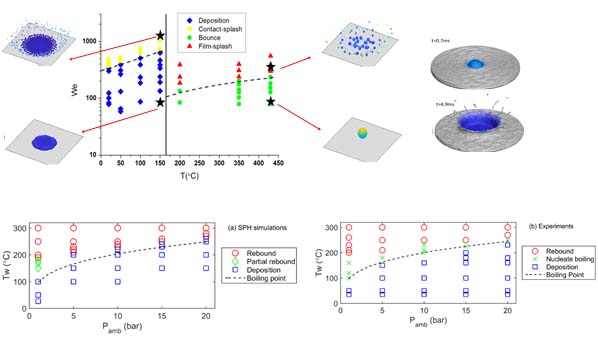
Physicochemical evolution of biomass particle in fast pyrolysis reactors
Fast pyrolysis is a prominent technology in converting waste biomass to combustible gases and liquids; pyrolysis also occurs at the early stage of solid fuel combustion. Fast pyrolysis-derived liquid fuels are regarded as an economically feasible alternative to fossil fuels and some facilities for heat and power generation have been brought online in recent years. However, despite its promising potential, the development of fast pyrolysis has been hindered by the complexity of reactor conditions in biomass pyrolysis, and to date, methods capable of predicting the detailed processes are unavailable. This study is to characterize accurately the behaviors of biomass particles and predict the product yields of a fast pyrolysis reactor by using high-fidelity numerical simulations. The proposed research activities will lead to advances in the fundamental science of biomass pyrolysis for energy applications.
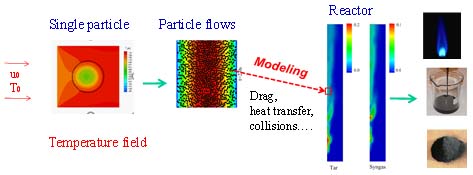
Experiments on low-temperature diesel combustion
This research is motivated by the federal emissions mandates, demands for fuel economy and durability, and the desire to explore the complex spray combustion phenomena in engines. Low-temperature combustion is a strategy to reduce both NOx and particulate matter (or soot) emissions simultaneously. We strive to optimize engine operating conditions and combustion chamber geometry to achieve low emissions and high efficiency. The present approach is to utilize the advanced fuel injection system, ultra-high injection pressure, non-traditional injector nozzle designs, and exhaust gas recirculation to achieve low temperature combustion. The goal is to reduce exhaust emissions while maintaining high efficiency.
Optimization methodology
Diesel low-temperature combustion can be achieved by using EGR, flexible fuel injection schemes, fuel reactivity control, boost pressure, etc. Eventually it is a matter of optimizing operating parameters to achieve the desirable features. To prevent the time-consuming parametric study, we have developed an algorithm based on Particle Swarm Optimization (PSO) to speed up the optimization. Based on a multi-cylinder John Deere engine, we integrated PSO with engine control systems for optimization. PSO has proven to be an efficient means of exploring optimal operating conditions to help achieve desirable conditions. Research is in progress to further explore favorable operating conditions for new engines.
Diesel spray combustion diagnostics
In collaboration with John Deere, we have built a constant-volume combustion chamber to investigate diesel spray, combustion, and emissions characteristics in a well-controlled environment.

Alternative Engine Fuels
In addition to conventional fuels, engine performance of using biorenewable fuels is also of our research interest. We perform engine tests and field studies to characterize engine emissions and fuel efficiency using various blends of biofuels including biodiesel, ethanol, renewable diesel, and pyrolysis oil derived from biomass. The goal is to develop fundamental understanding and strategies to adopt biofuels for engines.
Biodiesel combustion
Our past biodiesel engine research includes (1) developing strategies of low-temperature combustion using diesel/biodiesel blends, (2) field study of commercial trucks fueled with diesel/biodiesel blends, and (3) measurements of exhaust emissions of large utility diesel generators using blends of biodiesel and diesel in two power plants (shown in the pictures below).
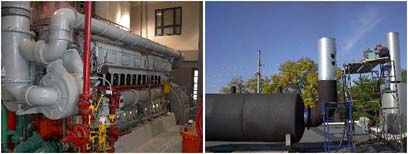
Energy recovery from waste plastics
Biodiesel happens to be a good solvent that can dissolve some plastic materials. This research explores the possibility of burning mixtures of biodiesel/polystyrene in a diesel engine as a means to recover the waste energy. Engine performance, including power and emissions, is characterized using various ratios of biodiesel and polystyrene.
Ammonia engine – a non-carbon fuel
Ammonia (NH3) is a carbon-free fuel whose combustion does not produce carbon dioxide, a known greenhouse gas. Hydrogen has also been regarded as a carbon-free fuel, but there are too many technical obstacles to achieve a hydrogen economy in the near future. In fact, ammonia can be viewed as a “hydrogen carrier” and has many benefits, including well-established infrastructure, high energy per volume, low energy to store, non-flammable, and easy to detect, etc. In recent years, new technologies have been developed to produce ammonia from renewable sources (e.g., wind, solar, solid-state synthesis), and thus ammonia can also be viewed as a renewable energy carrier. Our research group is the first to demonstrate that ammonia can be used in a modern compression-ignition engine using dual-fuel operation – ammonia and a secondary fuel. The fuel induction strategies include (1) gaseous ammonia induction to the intake manifold with direct-injection diesel fuel, and (2) direct injection of mixtures of ammonia and dimethyl ether. Research is in progress in using direct ammonia injection in a spark-ignition engine to increase the engine load limit.

Engine combustion modeling
Our work is among the first of its kind in incorporating detailed chemistry with 3-D computational fluid dynamics for homogeneous charge compression ignition engine simulation, and this approach has been widely adopted to characterize the fundamental low-temperature combustion processes. Overall, the research includes the development of various spray, fuel vaporization, heat transfer, combustion, and soot emissions models.
CFD with Detailed chemistry
We are developing high-fidelity computational fluid dynamics models that feature detailed chemical kinetics to simulate autoignition, fuel oxidation, and soot and NOx emissions. Accurate numerical schemes based on adaptive mesh refinement are also developed for efficient simulation. The ultimate goal is to develop predictive numerical models that can be used as a tool for engine design and optimization.

Multicomponent petroleum-biofuel vaporization
In real-world applications, liquid biofuels are blended with petroleum fuels, and there is a strong demand in increasing biofuel concentration in the blends. However, one of the major challenges to the widespread application arises mainly from the unusual fuel properties of these fuel blends. These fuel mixtures are often modeled using binary components that, unfortunately, do not faithfully represent the actual fuel effects. Multicomponent vaporization modeling is one of the keys to the accurate prediction of mixture distribution which, in turn, will determine the accuracy of combustion prediction. We have developed multicomponent vaporization models based on a hybrid approach – using continuous thermodynamics to represent petroleum fuels and discrete component methods to simulate biofuels. Sample results are shown below. Work is in progress in extending the modeling capability to predict vaporization of novel biofuels, e.g., various bio-oil fractions derived from fast pyrolysis of lignocellulosic biomass.

Bio-oil gasification
Fast pyrolysis of biomass to produce bio-oil has moved to the forefront of bioenergy research and development. Bio-oil, which is a mixture of complex oxygenated hydrocarbon species, is much easier to transport than bulky solid biomass. A novel approach is to convert biomass to bio-oil at widely distributed small-scale processing plants, transport bio-oil to a centralized location, gasify bio-oil to syngas, and upgrade the syngas to transportation fuels. This research is to investigate this approach through a combination of experimental and analytical studies that can potentially lead to the large-scale commercialization of this technology that has the potential to turn agricultural residues (e.g., corn cobs, corn stover, switchgrass, etc) into valued feedstock. This project is sponsored by Iowa Energy Center. Our group, as a team member of Bioeconomy Institute, will conduct experiments, technoeconomic analysis, reactor simulation, and plant optimization of biorefinery based on bio-oil gasification.
Biomass gasification and syngas combustion
This research is focused on the utilization of biomass energy based on the gasification platform. Thermochemical gasification is a promising technology that is less restricted to the type of biomass. Gasification takes place at moderately high temperature and turns solid biomass into combustible gas mixtures (known as synthesis gas or syngas) through simultaneous occurrence of exothermic oxidation and endothermic pyrolysis under limited oxygen supply. Syngas derived from biomass gasification can be burned to generate heat and power or synthesized to produce liquid fuels.
The research is performed on a pilot-scale gasifier that incorporates a novel gas conditioning system for gas cleanup and an oxygen-enrichment system for gas upgrade. The gasifier consumes 5 tons per day of feedstock. Advanced instrumentation based on gas chromatograph and mass spectrometer (GC-MS) is used for characterizing the syngas composition as well as the exhaust flue gas emissions from the burner. This gasification/combustion system is being facilitated to develop clean burner for syngas combustion.
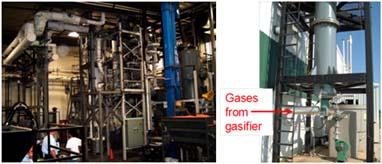
Gasification of biomass with controlled nitrogen contents
During gasification, nitrogen in biomass is released as ammonia which, in turn, will result in significant “fuel NOx” emissions after combustion of syngas. Thus, research is conducted to characterize the relationship between nitrogen content in biomass feedstock, ammonia concentration in syngas, and NOx emissions in flue gas. Various feedstock with controlled nitrogen contents are tested, including wood, wood+7%DDGS, wood+13%DDGS, wood+20%DDGS, and wood+40%DDGS, with nitrogen varying from 0.14 to 1.75 wt%. These results provide guidance to the burner design in order to burn biomass-derived syngas successfully with low NOx emissions.
Biomass gasification using oxygen-enriched-air and steam
Biomass gasification using air produces a low heating value syngas (4 to 7 MJ/Nm3) that is only suitable for heat and power generation. On the other hand, steam and oxygen can increase the heating value of syngas (10 to 14 MJ/Nm3) as well as the main gas constituents of H2 and CO that are suitable for liquid fuels production through the FT synthesis. We conducted experimental research using different feedstock and gasifying agents. The gasifying agents include air, 45% oxygen with steam, and 80% oxygen with steam. A 1500-gallon liquid oxygen maintained at −400 ºF is used to supply oxygen. Results indicate that oxygen-enriched-air and steam gasification favors the production of combustible gas components. Hydrogen can increase by 70% and carbon monoxide by 34% when the highest concentration of oxygen is used.
Low fuel NOx burner development
Traditionally gas burners are designed and optimized for low thermal NOx emissions. To enable the clean combustion of biomass-derived syngas, a burner needs to mitigate the fuel NOx emissions resulting from ammonia combustion in the syngas. Research is conducted to develop accurate computational models and chemical reaction mechanisms that can simulate biomass-derived syngas combustion. Computational results are validated using experimental data from our pilot-scale gasifier/combustion system, and the models are used to design a new burner that can mitigate fuel NOx emissions.
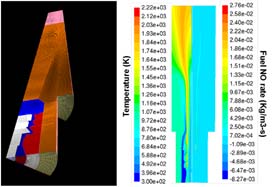
Integration of geothermal energy into biorefinery
Geothermal energy originates from the original formation of the planet as well as the radioactive decay of the minerals. Geothermal energy can be used in various ways, including direct use, electricity production, and heat pumps. Each geological region has its own geothermal conditions. For regions with abundant agricultural products such as Iowa, it can be of great interest to combine both biomass and geothermal energy. This research is to study the feasibility of utilizing geothermal energy in a biorefinery that produces liquid transportation fuels. Geothermal steam is used for biomass drying, gasification, steam-methane reforming, and electricity production (via Organic Rankine Cycle). Such integration provides a new way of combining two renewable energy technologies to produce renewable fuels.
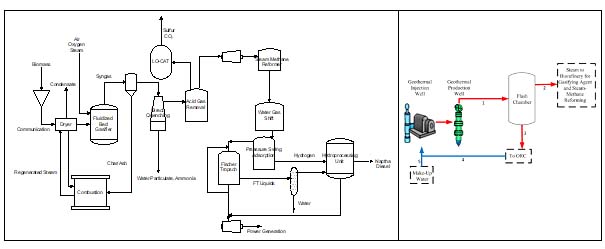
Reacting Flow Research Laboratory
-
Address
Texas Tech University, 2500 Broadway, Lubbock, TX 79409 -
Phone
806.742.2011 -
Email
webmaster@ttu.edu
